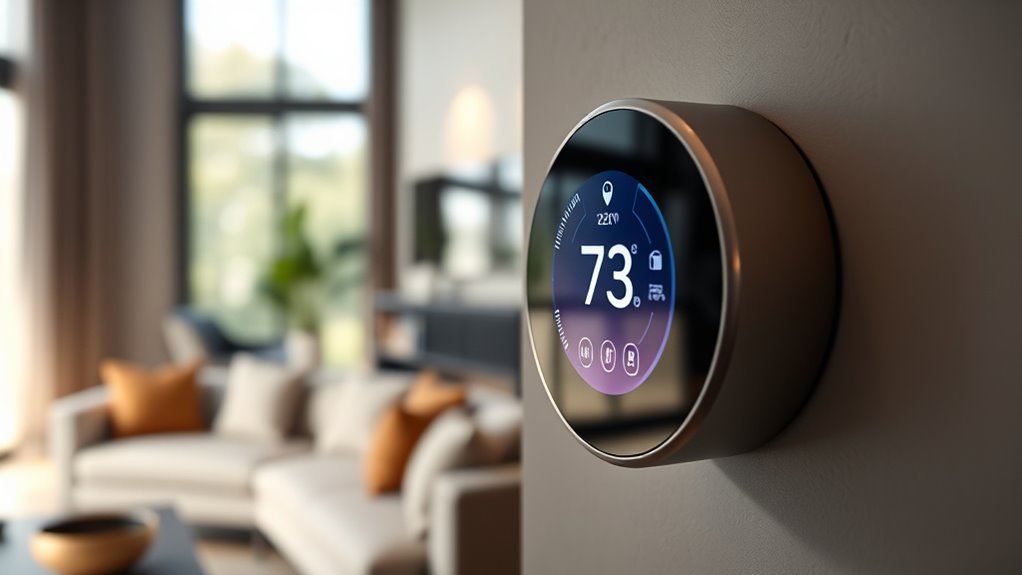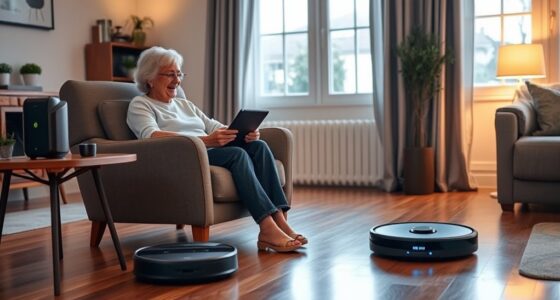Voice-controlled thermostats let you manage your home’s climate easily with your voice, integrating with virtual assistants like Alexa, Google Assistant, or Siri. They use microphones and voice recognition to interpret commands, connect via Wi-Fi, and often include features like remote control, schedules, and privacy controls. Popular models support smart home ecosystems and offer energy-saving options. To learn about choosing the right model, installation tips, and troubleshooting, explore more about these innovative devices.
Key Takeaways
- Voice-controlled thermostats enable hands-free climate management via voice commands through smart speakers or virtual assistants.
- They support integration with ecosystems like Alexa, Google Assistant, and Siri for seamless automation.
- Features include remote access, scheduling, AI learning, and privacy controls to enhance convenience and security.
- Proper installation may require checking wiring compatibility, especially the presence of a C-wire, and following safety procedures.
- Benefits include energy savings, improved comfort, and easy control, while troubleshooting common connectivity issues enhances user experience.
How Voice-Controlled Thermostats Work
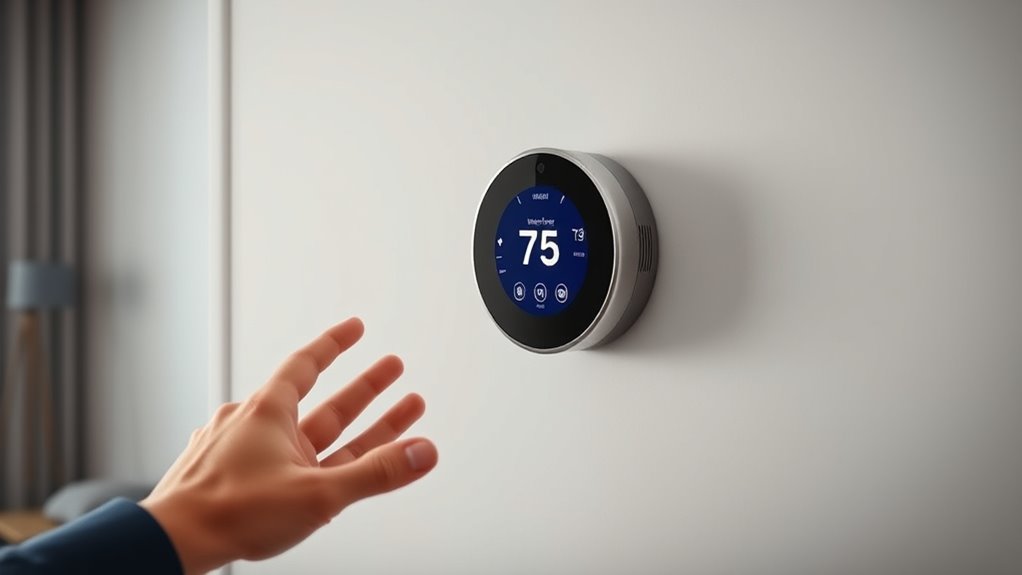
Voice-controlled thermostats work by using microphones to pick up your spoken commands and voice recognition technology to interpret them. When you speak, the device captures your voice and processes it through advanced algorithms that understand your intentions. They are designed to provide a smooth and reliable user experience, ensuring accurate response to your commands. These thermostats are integrated with virtual assistants like Alexa, Google Assistant, or Siri, allowing you to control your home’s temperature hands-free. They connect to your Wi-Fi network, giving you remote access via smartphone or smart speakers. Many models can understand natural language, so you can ask about the current temperature or make adjustments casually. The system then controls your heating or cooling based on your instructions. Additionally, some models include privacy features that help manage data security and user privacy, preventing unauthorized access. Plus, they include privacy features to guarantee your data stays secure and prevent unauthorized voice commands.
Key Features to Consider in a Voice Thermostat
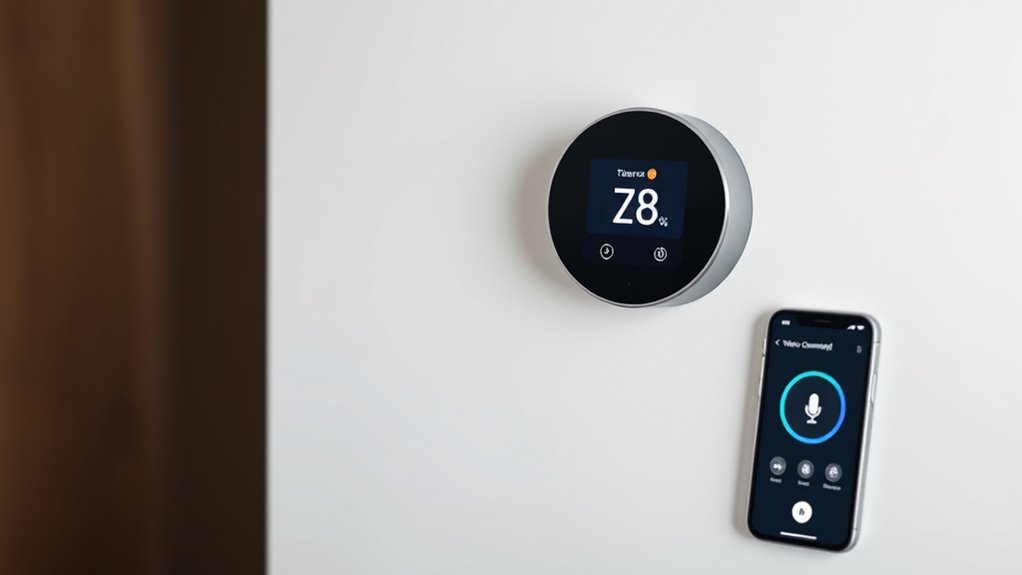
When selecting a voice thermostat, several key features can significantly enhance your experience and guarantee it meets your needs. A Wi-Fi Smart Thermostat is essential for remote control via smartphone apps, letting you modify settings from anywhere. Voice Control capabilities are equally important; look for models supporting popular voice assistants like Alexa, Google Assistant, or Siri to enable hands-free commands. Built-in microphones and speakers ensure seamless voice interaction and quick responses. Compatibility with your existing smart home ecosystem allows for automation, scheduling, and personalized climate regulation, making your system smarter and more efficient. Advanced features like multi-room voice commands and customizable responses can further improve usability, providing a more intuitive and tailored experience. Additionally, understanding the role of sound quality in smart devices can contribute to clearer voice command recognition and overall better performance. Ensuring your device has good audio clarity is crucial for effective voice control and user satisfaction. Incorporating local legal knowledge can help tailor your smart home system to comply with regional regulations and standards, enhancing safety and compliance. Exploring asset division principles can also inspire innovative features for future smart thermostat designs, blending entertainment and functionality. Prioritizing these features guarantees your voice thermostat is both functional and user-friendly.
Top Models and Their Capabilities
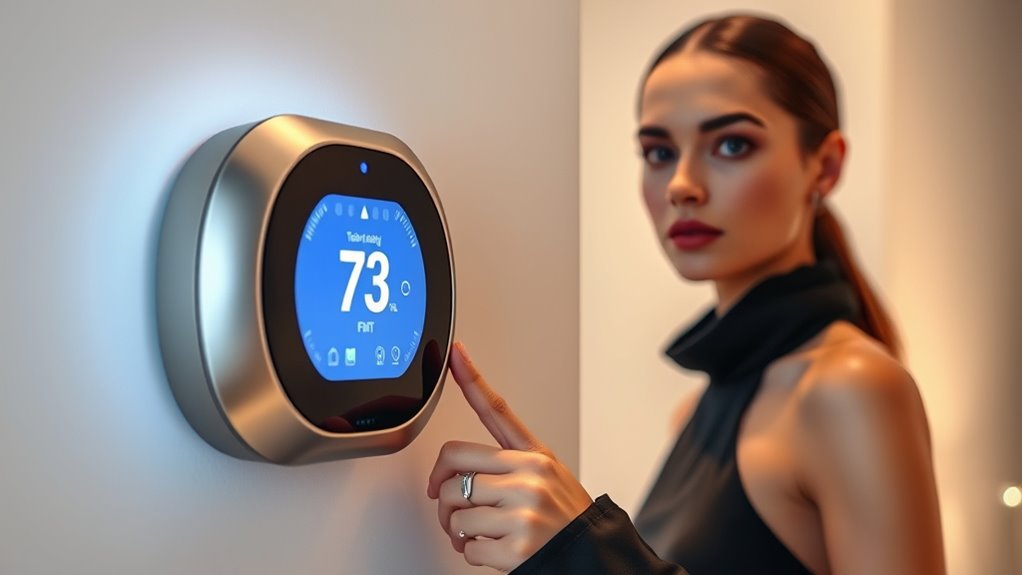
Different models offer a range of smart features and compatibility options to suit your needs. Price varies widely, from budget-friendly choices to premium systems with advanced integrations. Understanding these differences helps you select a voice-controlled thermostat that fits your budget and smart home setup. For instance, some models can be integrated with home automation systems, enhancing overall convenience and control.
Smart Features and Compatibility
Top models like the ecobee SmartThermostat Premium, Google Nest Learning Thermostat, and Honeywell RTH9590WF offer advanced smart features that make voice control seamless.
These thermostats support compatibility with major voice assistants such as Amazon Alexa, Siri, and Google Assistant, allowing you to adjust settings hands-free. Built-in microphones, speakers, or existing voice assistant compatibility enable you to control your thermostat easily and receive updates through voice commands.
Compatibility with platforms like Apple HomeKit, Samsung SmartThings, and others guarantees smooth integration into your smart home ecosystem.
Many models also support remote control via smartphone apps and offer features like scheduling, AI learning, geofencing, and voice-activated routines. These capabilities make managing your home’s temperature both effortless and intuitive.
Price Range and Integration
Prices for leading voice-controlled thermostats like the ecobee Smart Thermostat Premium and Google Nest Learning Thermostat range from about $129.99 to $249.99, reflecting their advanced features and capabilities.
These smart thermostats leverage Wi-Fi connectivity to seamlessly integrate with your smart home ecosystem. With compatibility for Amazon Alexa, Apple HomeKit, Google Assistant, and Samsung SmartThings, you can control your device effortlessly through voice commands or apps.
Ecobee models often include built-in microphones and speakers for hands-free voice control, while Nest relies on external voice assistants. Voice recognition technology enhances their ease of use and responsiveness.
Premium models offer extra features like air quality monitoring, sensors, and AI learning, all accessible via compatible smart speakers and apps. Efficiency and integration are key factors driving their popularity among homeowners.
The smart home ecosystem integration capability allows users to automate and customize their climate control for maximum convenience. Additionally, compatibility with various platforms ensures that these thermostats can be easily incorporated into existing smart home setups, providing versatile, connected comfort control. Newer models are also continually improving user experience with faster response times and more intuitive interfaces.
Compatibility With Smart Home Ecosystems
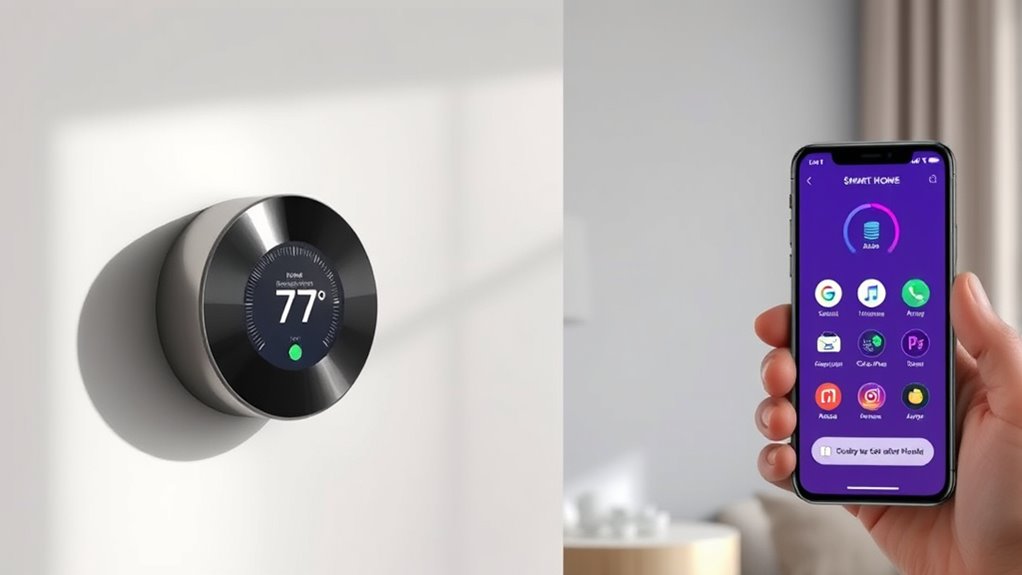
Many voice-controlled thermostats seamlessly integrate with major smart home ecosystems like Amazon Alexa, Apple HomeKit, Google Assistant, and Samsung SmartThings, enabling you to control your climate with simple voice commands. With a compatible Smart Thermostat, you can easily adjust temperature settings, set schedules, or turn your system on and off using just your voice. Compatibility with smart home ecosystems enhances the overall convenience and functionality of your home automation system, making it easier to manage your climate effortlessly via voice, apps, or smart speakers. Incorporating interoperability standards ensures smooth communication between devices, increasing reliability and expanding your smart home capabilities. Additionally, supporting smart device standards promotes compatibility across a wide range of products and brands. Establishing consistent device communication protocols is essential for maintaining a reliable and integrated smart home environment, especially as cultural intelligence emphasizes understanding diverse user needs and technical preferences to improve overall system performance.
Installation and Setup Tips
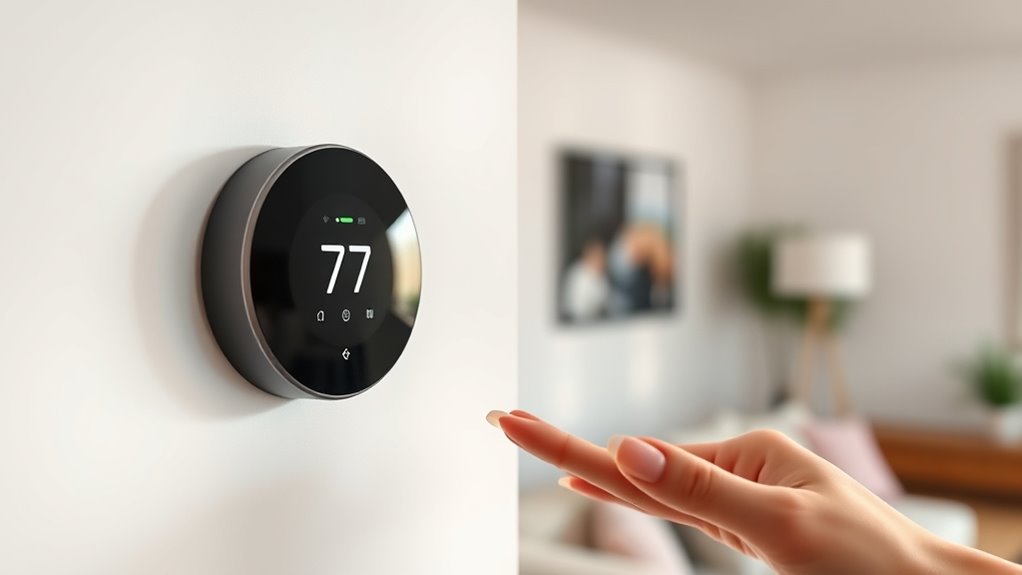
Before you start installing, check if your system has a C-wire, since many smart thermostats need it for power. Use the manufacturer’s wiring decision tree or videos to verify everything connects correctly and safely. Always double-check your wiring before turning on the system to avoid issues during setup. Being aware of necessary wiring components can help ensure a smooth installation process. Additionally, understanding survivability considerations can be beneficial in case of unexpected power fluctuations or outages during installation. Knowing how to handle power disruptions can prevent potential damage and ensure continuous operation. Incorporating proper surge protection can further safeguard your thermostat from sudden voltage spikes, enhancing its power resilience. For example, some thermostats include backup batteries or surge protectors to enhance their power resilience.
Wiring Compatibility Checks
To guarantee your smart thermostat functions properly, start by verifying that your HVAC system has a C-wire, which provides continuous power. This is essential for ensuring compatibility and reliable operation. Incorporate sound healing techniques into your setup process to promote a calm and focused installation experience. Use a wiring diagram or decision tree to check that your existing wires are correctly connected and support smart thermostat installation. If your current setup lacks a C-wire, consider installing a dedicated one or using a compatible power extender kit to avoid power issues. For high-voltage or thick wires, consult manufacturer guidelines to determine if wiring modifications are necessary before proceeding. When wiring isn’t clear, online tutorials or manufacturer support resources can help troubleshoot and confirm compatibility, ensuring a smooth and secure installation process. Additionally, verifying that your thermostat’s wiring matches the standard wiring configurations can prevent potential issues during setup. Understanding security zone info can also help you safeguard your connected devices from cyber threats that could compromise your smart home system.
Using Proper Tools
Using proper tools is essential for a safe and successful smart thermostat installation. Gather your wireless tools, like a screwdriver, wire strippers, and a multimeter, to ensure all connections are secure and compatible. Before starting, turn off the power at the breaker to prevent shocks. Label the existing wiring terminals (R, W, Y, G, C) to make reconnection easier. Use a multimeter to verify voltage at the wiring, confirming the presence of a C-wire if needed. Here’s a quick visual:
| Tool | Purpose | Safety Tip |
|---|---|---|
| Screwdriver | Connect/disconnect wires | Turn off power before use |
| Wire Strippers | Prepare wires for connection | Keep wires organized |
| Multimeter | Check voltage and compatibility | Verify power before handling |
Proper tools make your setup safe, efficient, and reliable.
Energy Savings and Cost Benefits
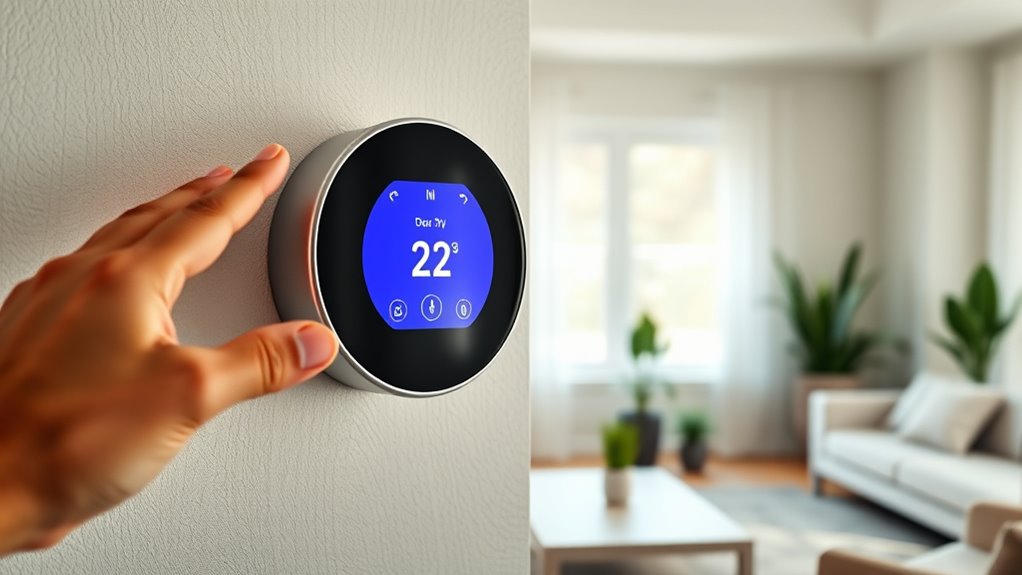
Smart thermostats offer significant savings by reducing heating and cooling costs—up to 26%, which can amount to around $284 annually. With a Smart Thermostat with Voice, you can maximize energy savings through features like automatic adjustments based on occupancy and energy rates.
To boost savings, you can:
- Set schedules that match your daily routine.
- Use eco+ mode to optimize temperature settings.
- Control the thermostat remotely when you’re away.
- Adjust temperatures quickly with voice commands.
These features help prevent energy waste, especially when no one is home. Keep in mind, actual savings depend on your local energy rates, insulation, and how effectively you use automation.
Security and Privacy Aspects
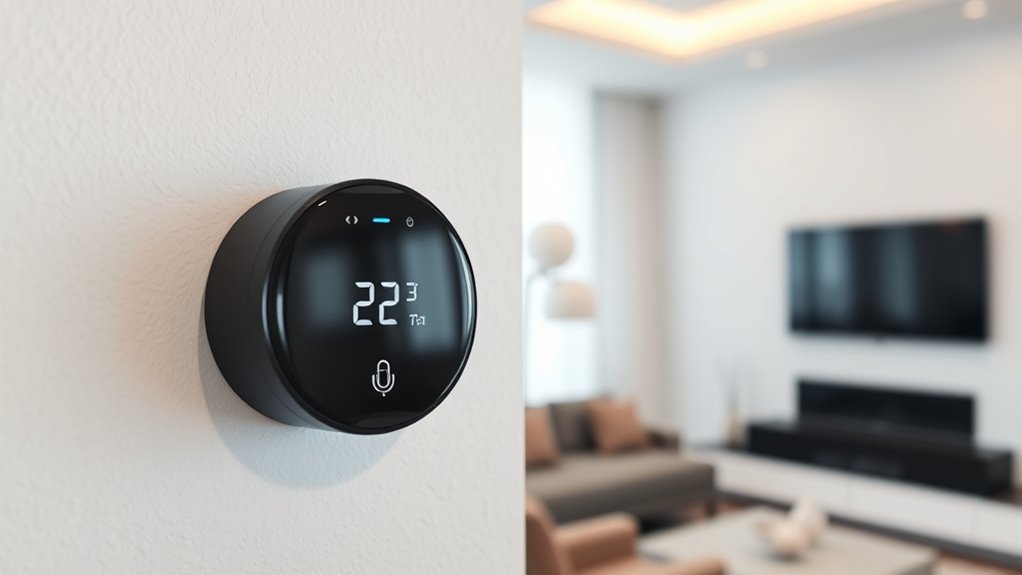
You should consider how data encryption protects your personal information from unauthorized access.
Voice command privacy depends on whether your device stores or transmits recordings, which can pose security risks.
Implementing device access controls, like strong passwords and user permissions, helps keep your thermostat and data secure.
Data Encryption Measures
To safeguard user data and guarantee privacy, manufacturers of voice-controlled thermostats implement robust encryption measures. These protocols ensure your information stays secure during transmission and storage. Here are key encryption practices:
- They use TLS (Transport Layer Security) to encode data sent between the device and cloud services, preventing interception.
- End-to-end encryption keeps voice commands and personal data private from start to finish.
- Stored user data is encrypted locally on the device with AES-256, protecting it even if the device is physically compromised.
- Regular firmware updates include security patches that address vulnerabilities in encryption and privacy measures.
Voice Command Privacy
Have you ever wondered how voice command privacy is protected in thermostats? Your privacy depends on how well the device secures your voice data. Many models let you disable voice recording or limit data sharing, giving you control over your privacy. Data from voice commands is usually encrypted during transmission, but vulnerabilities can develop if devices aren’t kept updated. Manufacturers might store recordings on cloud servers, which could be risky if data breaches happen. Always review privacy policies to understand how your voice data is used and shared, and opt out of data collection when possible. Here’s a quick overview:
| Privacy Feature | Description | Best Practice |
|---|---|---|
| Disabling voice recording | Turn off recording to protect your voice data | Use privacy settings if available |
| Data encryption | Data is encrypted during transmission | Keep firmware updated |
| Cloud storage | Voice data stored on cloud servers | Review privacy policies |
| Data sharing | Information shared with manufacturers | Opt out when possible |
| Privacy controls | Settings to limit data collection | Regularly review and update privacy options |
Device Access Controls
Device access controls are essential for safeguarding your thermostat’s security and privacy. They prevent unauthorized users from gaining control and protect your voice data. Here’s what you should consider:
- Use voice recognition features to ensure only recognized voices can access your device.
- Set up PIN codes or app-based authentication to add an extra layer of security.
- Regularly update your device’s firmware to patch security vulnerabilities.
- Customize privacy settings to disable microphones or restrict voice data collection when needed.
These steps help you maintain control over device access and safeguard your privacy.
Integrating Voice Thermostats With Other Devices

Integrating voice-controlled thermostats with other smart devices creates a more cohesive and convenient home automation experience. With a smart thermostat, you can seamlessly connect it to systems like Amazon Alexa, Apple HomeKit, or Google Assistant, enabling voice commands for temperature control.
These thermostats often support multiple voice assistants at once, so you can adjust your home’s climate using devices like Echo, Siri, or Google Nest speakers. When integrated with smart lights, security cameras, or other devices, you can automate routines triggered by voice commands, such as lowering the temperature when you say goodnight or turning on lights simultaneously.
Connecting your thermostat to your home automation ecosystem makes managing your environment intuitive and hands-free, enhancing overall comfort and convenience.
Common Challenges and Troubleshooting

While connecting voice-controlled thermostats to your smart home enhances convenience, it can also introduce certain challenges. Wi-Fi issues are common, causing unresponsiveness or connection drops. Firmware glitches may also lead to voice recognition or control errors.
To troubleshoot, try these steps:
- Reset the thermostat to clear temporary glitches.
- Check your Wi-Fi connection and ensure it’s stable.
- Update the firmware to fix bugs and improve compatibility.
- Reconfigure the device if it’s not properly integrated with your smart home ecosystem.
Power problems, like insufficient C-wire connections, can also disrupt voice control, requiring wiring repairs.
Background noise, unclear pronunciation, or language settings might cause misinterpretation of commands, so calibrate your voice profile as needed. Addressing these issues helps keep your voice-controlled thermostat functioning smoothly.
Future Trends in Voice-Controlled Climate Control

Advancements in voice-controlled climate systems are set to make interactions more natural and intuitive than ever before. Future smart thermostats will leverage improved natural language processing, allowing you to have more conversational, context-aware Voice Control.
Integration with emerging AI will enable these devices to proactively suggest energy-saving adjustments based on your habits and environmental data, making climate control smarter.
Increased adoption of standards like Matter will enhance interoperability across your smart home ecosystem, simplifying control.
Security protocols and privacy controls will also improve, addressing concerns about voice data and unauthorized access.
Additionally, multisensory interfaces combining voice, gestures, and environmental sensors will create more seamless and intuitive climate control experiences, making your interactions with smart thermostats more effortless and personalized.
Frequently Asked Questions
Is There a Thermostat You Can Talk To?
You’re wondering if you can talk to a thermostat. Yes, many modern thermostats let you do that. They support voice commands through popular assistants like Alexa, Siri, or Google Assistant.
Some, like ecobee’s, have built-in microphones for direct voice interaction. You can ask them to adjust the temperature, change modes, or set schedules without lifting a finger.
It’s all about making your home more convenient and hands-free.
Is There a Monthly Fee for Google Nest Thermostat?
You’re wondering if there’s a monthly fee for the Google Nest Thermostat. The good news is, for basic features like remote control, scheduling, and voice commands, you won’t pay anything monthly.
Some advanced options, like energy reports or smart alerts, do require a subscription to Nest Aware, which costs monthly. But overall, the core functions of the thermostat are free, with optional paid services for extra features.
Which Thermostats Work With Siri?
You’re wondering which thermostats work with Siri. To control your thermostat with Siri, look for models compatible with Apple HomeKit.
The ecobee SmartThermostat Premium is a great choice, as it supports Siri through HomeKit.
Keep in mind, the Nest Learning Thermostat doesn’t natively support Siri, so you’d need third-party apps or bridges.
Always check if the thermostat explicitly states compatibility with Apple HomeKit for seamless Siri integration.
What Is the Difference Between Smart and Dumb Thermostats?
Think of smart thermostats as your personal climate wizard, while dumb ones are just old-fashioned dials. You control smart thermostats remotely via apps, and they learn your schedule, saving energy effortlessly.
Dumb thermostats only respond to manual adjustments. The main difference is connectivity and automation—smart models connect to Wi-Fi, support voice commands, and adapt to your habits, whereas dumb thermostats stick to basic, manual settings.
Conclusion
Choosing a voice-controlled thermostat can truly simplify your life and make your home more comfortable. As you explore options, remember that “the devil is in the details”—so prioritize features, compatibility, and security. With the right device, you’ll enjoy smarter climate control and seamless integration into your smart home. Take action today, and turn your house into a cozy, convenient haven where technology works for you.
